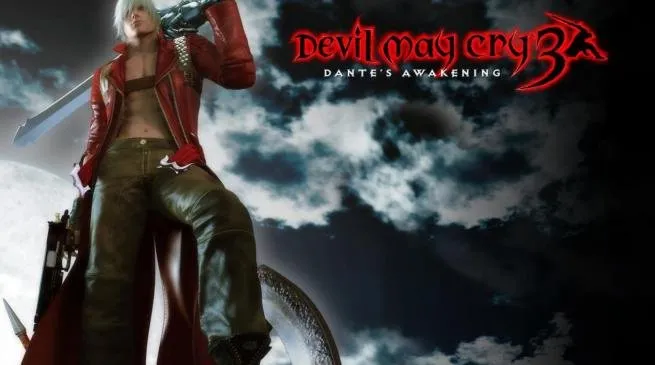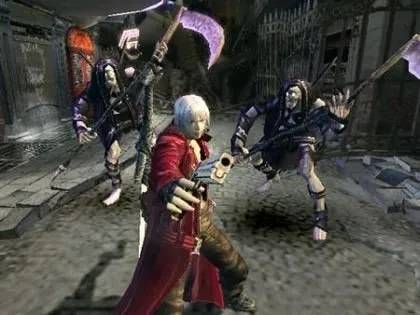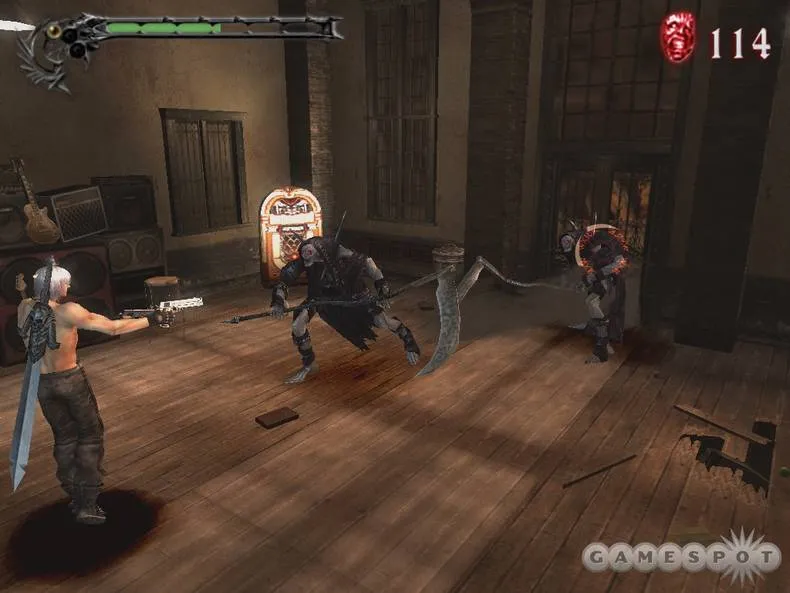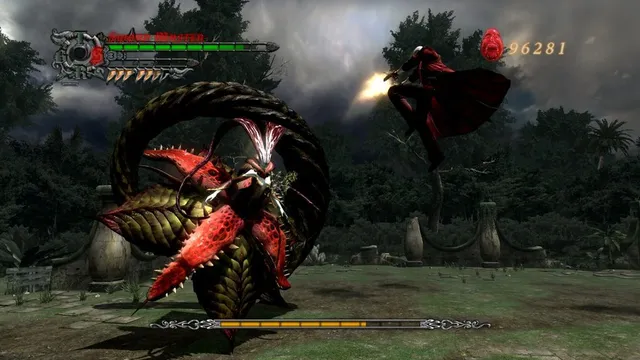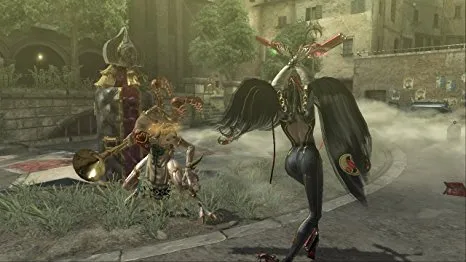For the first time in our compatible, the demonic fury of Sparda's son is here. Follow the young Dante through a special crusade against his twin brother and discover the power of the man who made the Devil cry.
At the beginning of February of this same year, Capcom announced that three of its star titles of recent times, in turn belonging to franchises already classic in the company and enjoying unbeatable health in the field of consoles, were going to give his passage to the world of the PC. The fourth installment of Resident Evil, a great game like the cup of a pine, the spectacular third part of Onimusha and the special edition of the adventures of half man and half demon Dante in Devil May Cry 3.
This is a strange movement, both on the part of the developer and on the part of the editor (Ubi Soft), to move to the world of compatible titles that are unthinkable in our system. But far from blaming it, it's a really interesting opportunity to bring genres to a platform that is scarce of them and, why not, to expand the spectrum of possibilities for both that new player who sits for the first time before the PC or for another more experienced person who wants to change the third.
In the dawn of the birth of the second Sony console, the archifamous PlayStation 2, the players were expectant before what would have to be for many the first great demonstration of the potential of the 'black beast'. Capcom, through Shinji Mikami, would give form to a new hero of classic style style Harry the Dirty, with gray hair and long red trench coat, who was armed in equal parts with an impressive sword, two pistols of great caliber (Ebony & Ivory) and a sharp tongue capable of releasing the sharpest answers at the key moment.
In February of 2001, although somewhat later and in different forms in our borders, Dante saw the light for the first time in an outstanding adventure that impressed critics and public and that received the name of Devil May Cry. His quick sequel was not long in coming, although not even from a distance had the quality or the hook of the first part despite having a female presence in its starring cast. Fortunately for Capcom, sales did not do justice to the game and were quite better than imagined, which led to this third installment we have today.
In a more studied and relaxed, the third of the deliveries would see the light in the form of a prequel to the first Devil May Cry, explaining many of the events already seen by the players and offering the struggle between the young Dante and his twin brother Vergil, with the desire of this one to get the unlimited power of Sparda sealed a long time ago. The result is broadly satisfactory from all points of view.
For those who are new to the saga, Devil May Cry is a title of action in the third person and free camera, frantic and able to put on screen multitude of different enemies simultaneously. Dante is a tireless machine to annihilate demons through a multitude of different ways, either with firearms or with swords. Throughout the game we will end up with hundreds or thousands of adversaries defeated behind us, learning new skills and developing our character through a compelling story and very well developed scenarios.
The version we have today is the special edition of Devil May Cry 3: Dante's Awakening. Essentially it is the same game that we analyzed in its day in the version of PlayStation 2, with the added contents of the 'special edition' and ported to PC by SourceNext. A look at this analysis is mandatory if you want to know more about Capcom's work in its original context and, in any case, as a complement to this text.
The original Devil May Cry received the nickname of 'Gothic action', largely due to the setting that received the epic in the castle of Mundus. In this case the course of events happens at the door to the beyond called Temen-ni Gru. We will not get out of it at any time of the game, although many parts have been deliberately altered to give some sense of freshness as we move through the game.
The DMC camera, historically one of the biggest problems in previous deliveries, places the action within what was expected in almost all of the occasions. However, to avoid those unpleasant blind spots in which we have no idea what we are hitting, it is possible to rotate it and even place it behind our protagonist. This is a situation that should be used relatively quickly if we do not want to succumb to an unknown sword.
The game is enjoyed with an exceptional fluidity in most of the game, even at 1024 x 768 (the maximum resolution at which he let us play). The framerate remains stable without appreciating downs in almost no moment of the game, and that is something exceptional because either there are enemies that occupy an enormity of the screen, or this one is full of them of continuous form. All this must be added many effects of all kinds, distortions by swords, objects that are broken, etc.
At the level of movements all the characters in the game are wonderfully well characterized. Dante has 4 styles of fight well differentiated and Vergil fights with his own, each one with its peculiarities and its fluid animations whatever happens before our eyes. The blows fly at vertigo speeds and are perfectly orchestrated by the combination of an excellent collision engine and an enviable response to the controls. The result is that our hero almost always does what we want.
The level of detail of both characters and scenarios is quite acceptable, although uneven in some points. The increase in resolution that has suffered the PS2 version does not translate into a proportional increase in the quality of the graphics, but we do see more definition and color, like we saw in Onimusha few weeks ago. The port, made by SourceNext, although too literal to its original version, we believe is done correctly.
At audio level Devil May Cry 3 presents a luxurious soundtrack, with hard rock and heavy metal hits sounding continuously through the speakers of our PC. The music honors the sound effects that resound after the innumerable hits and shots we make with the protagonists. The original dub, in English, presents a Dante younger than the original and it is a pity that in spite of the subtitles it is not translated into Spanish.
Devil May Cry 3 is one of those games that have a quite remarkable technical section, and that is not the most important part of the game. Generally our attention is so focused on ending the enemy hordes that little time we will have to enjoy the music or the multiple effects, reflections in real time, trails, games of lights ?? what is really important is to see how it all comes together to form a solid aspect, that I would appreciate something more detail in some points but that in general it fulfills adequately.
Capcom resorted to the old formula that says that if something is fine, it is not necessary to fix it; Devil May Cry 3: Special Edition is basically a game in which you have to kill everything that comes out ahead, as do so many other games on the market. But unlike in most of the Action RPG to which PC players are so accustomed, the role we take here is much more active at all levels and requires skills and expertise outside the ordinary.
There are numerous additions in this special version with respect to the original, something that we will discuss separately at the end of the analysis and the rest could well be rescued from the analysis of the PS2 version. However, we thought it appropriate to highlight the fundamental aspects of what for us has been the experience of playing Dante and Vergil on our PC and even at the risk of being repetitive and overlapping the impressions of another partner, we put it for you consideration.
The first important thing is to point out that, as we have said before, DMC is too literal a port. That means that playing it with a keyboard is practically inconceivable, extremely difficult, hateful and decimates the gaming experience. Playing it with a custom pad such as Logitech or, better yet, using a USB converter for a PlayStation 2 pad is by far the best option to enjoy the Capcom title. It is almost inconceivable to do otherwise.
Once adjusted the controls we realize how adapted Dante is to our movements. Not only can we take the character to any of the directions but we can fix our eyes on an objective and move around it. There are a lot of different combos, many of them that change through a subtlety when executing them, and we will see ourselves using a good number of them throughout the adventure.
The main reason for this is precisely the possibility of playing through any of the 4 fighting styles that have been included in the game, each with its strengths and its weak points, all of them widely differentiated from each other and some with great reminiscences of the 'old Dante' while others offer visions of the fight in a certain way that we had not seen so far.
While 'swordmaster' mostly uses short-range and sharp weapons to become the master of the sword as its name suggests, 'gunslinger' does the same with firearms to make a dent in enemies several meters away. 'Royal Guard' is the option for the eminently defensive player and 'trickster' makes use of striking and withdrawal strategies and evasion very spectacular, but at the same time more difficult to master. Lovers of the nostalgic Dante will find in the first two his Dante of all life, while the most daring can try the following.
Although the game obviously rewards them all being used, later in the adventure we will be able to unlock 2 new styles that will delight fans: 'quicksilver' has the ability to stop time in the Prince of Persia style while Doppelganger creates a series of doubles of oneself that are added to the combat inflicting enormous amounts of damage to the enemies.
During more than 20 missions we will fight against hordes of up to 40 different enemies; At the end of each mission we will obtain the relevant assessment based on the time spent, damage inflicted, aid objects used, etc. As we progress through the levels we will gain experience (in the game, I mean) that we can use buying new skills to make our character an almost invincible being.
Our arsenal of weapons is also something worth mentioning, and depending on the choice we make at the beginning of the level it will be one or the other. Although that limits the options, it includes the spectacular Nevan guitar, whose range can be increased by spending enough red orbs, or the Agni & Rudra talking scimitars. A cropped or a powerful bazooka will be good complements for the Ebony and Ivory pistols that, for the first time, can shoot in more than one direction simultaneously.
The dominance of the combos is something essential in any Mata-Mata de Capcom, although it is true that the pounding of buttons is a fundamental technique that initially serves to kill most enemies. The domain of chain attacks is not only important to win style in front of friends who are watching the fight, but for certain enemies it is necessary to use certain strategies if we want to ensure victory.
Since Dante is the son of Sparda, that demon who rebelled against those of his class sacrificing himself to seal evil on the other side of reality, the powers of our protagonist go according to that offspring. Although already from the impressive initial sequence this becomes evident, from time to time it is in our power to press the Devil Trigger, the skill that makes Dante an indestructible being that regenerates health. Of course, that does not happen until well into the adventure.
Historically the combats against the final bosses in Devil May Cry have been applauded (all console players remember 'the spider' from the beginning of DMC 1) and in this sense this third installment does not disappoint at all. Although it is relatively easy to learn the pattern of movement of these leaders, surely defeating them all is an exercise of moderate difficulty for the majority, especially for those not accustomed to gender.
One of the important purchase arguments of this version is that we get the special version of Devil May Cry 3, available on PS2 in the American market for some time but that has been delayed in our territory. That makes PC users can enjoy the first of the extras that this edition incorporates, and while some seem to be stuck with shoehorn others are truly important and greatly affect its gameplay.
Since the American version of the game was more difficult than the European and Japanese versions, a new level of difficulty has been added. This increase in difficulty contrasts sharply with the new save / retrieve method that comes with the game, which contrasts sharply with the previous one. Previously, when our character died, we were transported to the beginning of the level to repeat it entirely. If we had yellow orbs, prohibitive especially at the beginning, we could recover life before the encounter in which we had lost our lives.
This time the game enables a system of checkpoints from which we will reappear in case of death, greatly simplifying things and decreasing the time between death and death. If we have yellow orbs, in addition, we can recover life at exactly the same point at which we lost it; that means that depending on our stock of orbs we can have 2 or more energy bars to end up with a final boss, for example, which makes things a lot easier. Fortunately it is an optional system that is chosen at the beginning of the game.
The most striking addition is probably the inclusion of Vergil as a playable character within the game, as long as we have finished the game. Although it only has one style and a small arsenal of weapons, we can take Dante's twin brother through the same levels and see how powerful his handling is. Gain skills like the rest but start directly with the Devil Trigger and thanks to its superior net strength it is even easier to reach the end of the game with Vergil than with Dante. The development of the game does not change at all, but it is still interesting.
A Bloody Palace has also been added, a kind of survival in which for a whopping 9,999 stories (yes, you have read correctly) we will fight against the rival hosts putting to the test both the infernal hordes and our resistance to the controls. Fortunately it is possible to advance 100 in 100 floors if desired, although it is not possible to save at any time of survival. Only recommended for hardcores.
conclusion
Devil May Cry 3 Special Edition (PC) More costumes available, new videos and the possibility of increasing speed by 20% complete the list of extras of this special edition of Devil May Cry 3. But the really special thing is that the exclusive PC players have the opportunity to live one of the best franchises consoleras in our system and why not say it, one of the most competent action games of the market. From here we applaud the idea and give kudos to the editor so that they are encouraged to bring the best games of all systems to this platform. - Dante in our PC- The extras of the special edition- Frenzied action in its purest state- The style system
The best
- Frenzied action in its purest state
- Dante in our PC
- The style system
- The extras of the special edition
Worst
- Minor camera errors
- The null possibility of playing it with keyboard
- Not too well optimized for PC
Game of remarkable finish that we will enjoy and remember. A good purchase, highly recommended for lovers of the genre. It is well cared for at all levels.
